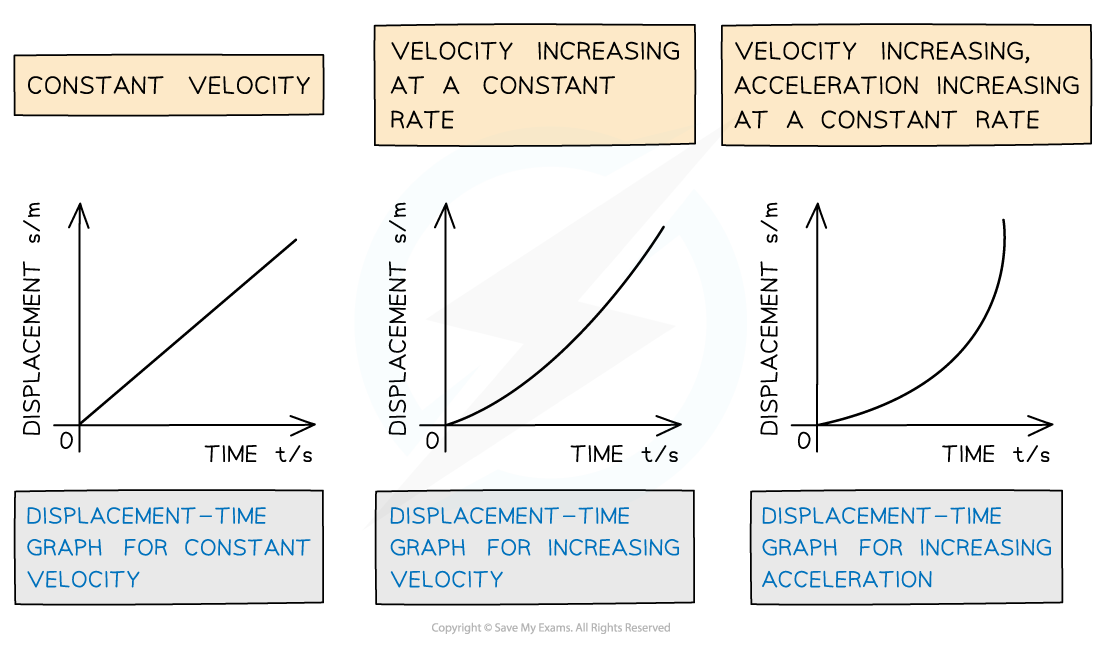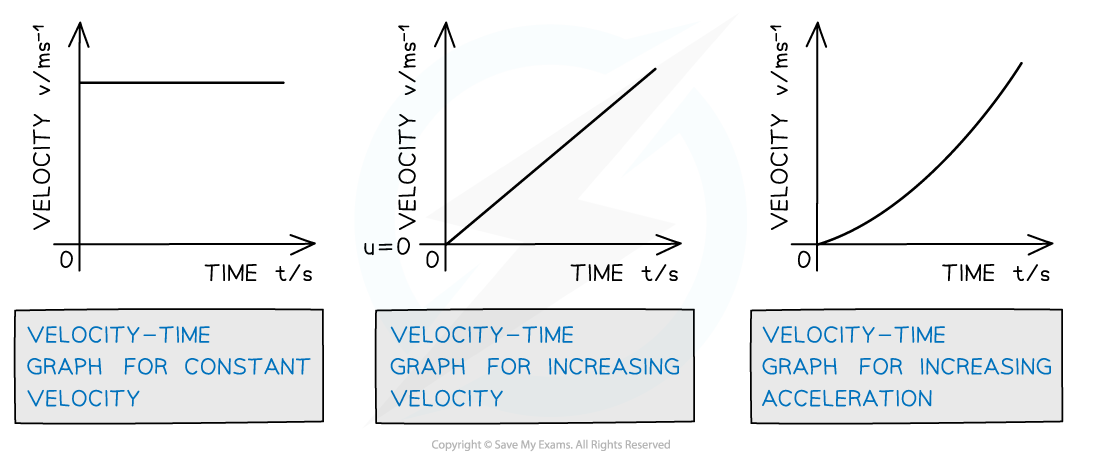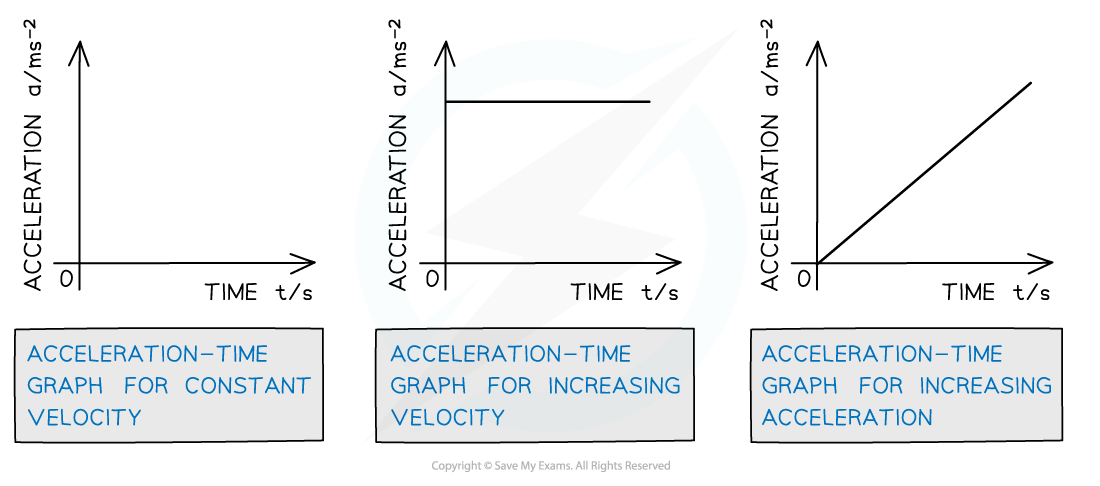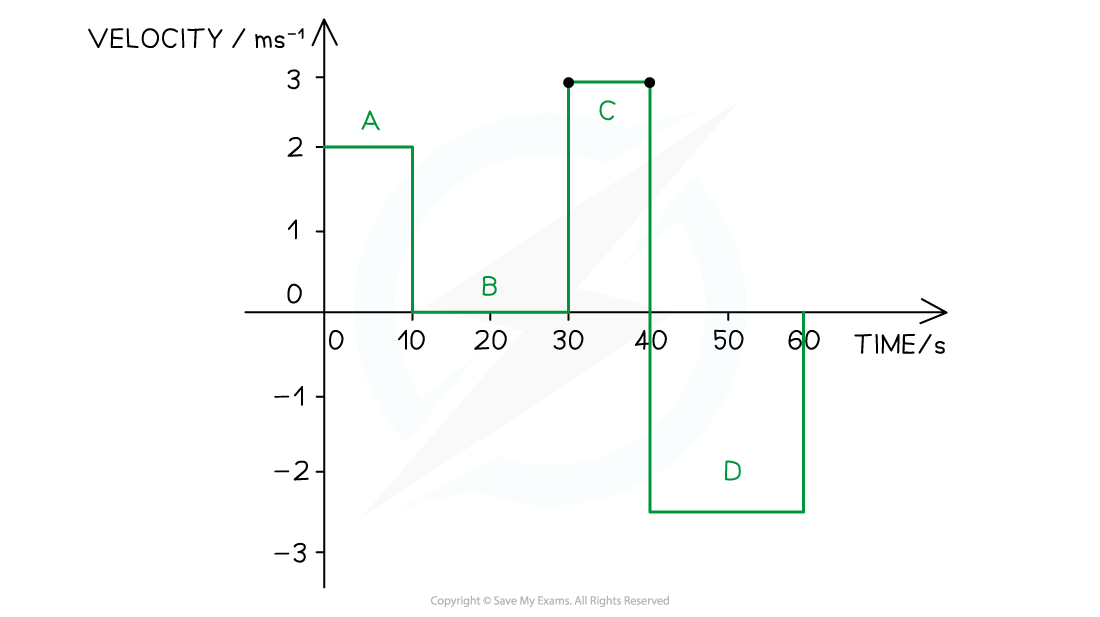Motion Graphs (Edexcel International A Level Physics) : Revision Note
Motion Graphs
Three types of graph that are used to represent motion are displacement-time graphs, velocity-time graphs and acceleration-time graphs
Graphs are named 'y-axis - x-axis', so 'displacement-time' simply means 'displacement on the y-axis and time on the x-axis'
Graphs of motion can be thought of as telling a story of something which has happened in the real world, such as
the time, direction and average speed of a journey to school
initial and final velocity and acceleration as a rocket takes off from the launchpad
movement and speed in various directions as an athlete takes part in an event
Interpreting graphs means using the slope of the line, or the area under the line to find information about that 'story'
Drawing graphs is a skill where careful planning, plotting and line drawing from some data yields further information from an investigation
Displacement-Time
On a displacement-time graph;
Slope equals velocity
A straight (diagonal) slope represents a constant velocity
A curved slope represents an acceleration
A positive slope represents motion in the positive direction
A negative slope represents motion in the negative direction
A zero slope (horizontal line) represents a state of rest
The area under the curve is meaningless

Velocity-Time
On a velocity-time graph…
Slope equals acceleration
A straight line represents uniform acceleration
A curved line represents non-uniform acceleration
A positive slope represents an increase in velocity in the positive direction
A negative slope represents an increase in velocity in the negative direction
a zero slope (horizontal line) represents motion with constant velocity
The area under the curve equals the displacement or distance travelled

Acceleration-Time
On an acceleration-time graph…
A zero slope (horizontal line) represents an object undergoing constant acceleration
The area under the curve equals the change in velocity
The steepness of the slope is meaningless

How displacement, velocity and acceleration graphs relate to each other
Drawing Graphs
Drawing a good graph is an important skill
Good graphs have the following:
Each axis has two labels; the name of the variable and the unit (and may include a multiplier, for example, m × 10−9)
Values on the axes are evenly spaced, with the same number of divisions for each amount

The axes start at the origin only when this fits the data or the relationship being graphed is directly proportional or when specified in the question
Increments on the scale are in multiples of 2, 5 and 10 but never multiples of 3.
The range of values being plotted takes up the length of the axis, so that the plotted line takes up most of the space on the graph
Plots are accurate to within half a small square
Plots and curves are drawn with sharp pencil so that they are narrow (don't take up more than half a small square)

Lines of best fit match the data, so that lines go through as many of the plots as possible (ignoring outliers) with the remainder evenly spaced above and below the line

Worked Example
A runner is practicing short sprints between two markers. A displacement-time graph showing part of their training is shown.

(a) Find the distance between the markers
(b) Determine the speed of the runner at the fastest part of their sprint
Answer:
Part (a)
Step 1: Determine the direction of motion from the graph
Initially displacement increases from 0 - 50 m
This represents the sprinter running away from the starting position
Secondly displacement decreases from 50 - 0 m
This represents the sprinter returning towards the starting position
Step 2: Identify the sprinter's turning point on the graph
The distance between the markers is from 0 → turning around point
This is 50 m from the start point
Step 3: Write the correct answer
Distance between the markers = 50 m
Part (b)
Step 1: Identify the part of the graph that represents the velocity
The graph shows displacement against time
Velocity is equal to:
Therefore, the slope of the displacement-time graph gives velocity
Displacement × time (area under the graph) is not a physical quantity
Step 2: Identify the steepest section of the graph
Select the section on the graph where the slope is the steepest
This represents the fastest velocity
Clearly mark two points on this line which are as far apart as possible

Step 3: Use the coordinates from the graph to calculate the slope
slope = = 7.5 m s−1
Step 4: Write down the answer to the correct number of significant figures
The sprinter's fastest speed = 7.5 m s−1
Worked Example
Motion has been plotted on a displacement-time graph.

Sketch a velocity-time graph for this motion. Include values and show your calculations.
Answer:
Step 1: Calculate each stage:
Part A
Step 1: Determine the time interval
Time from 0 - 10 s
Step 2: Calculate the velocity by finding the gradient
Gradient = =
= 2 m s−1
Part B
Step 1: Determine the time interval
Time from 10 - 30 s
Step 2: Calculate the velocity by finding the gradient
Gradient = 0 (horizontal line), velocity = 0 m s−1
Part C
Step 1: Determine the time interval
Time from 30 - 40 s
Step 2: Calculate the velocity by finding the gradient
Gradient = =
= 3 m s−1
Part D
Step 1: Determine the time interval
Time from 40 - 60 s
Step 2: Calculate the velocity by finding the gradient
Gradient = =
= − 2.5 m s−1
Step 2: Use the calculated values to sketch a graph

Examiner Tips and Tricks
Interpreting Graphs
It's common for a question to ask you to solve something 'using a graphical method'. This just means 'by finding your answer on a graph'.
In AS Physics most (but not all) graphs will be a straight line, meaning they follow the equation y = mx + c
This means that the 'graphical method' question is asking you to look at the gradient, or the area under the line. Once you are secure in finding these then graph questions will become much easier!
Drawing Graphs
A well-drawn graph will net you four or five quick and easy marks IF you have practiced the skill.
Common mistakes are starting at the origin when there is no need (so the line takes up less than half of the page) and trying to work with a scale that goes in multiples of three (making it hard to get the plotting right).

You've read 0 of your 5 free revision notes this week
Sign up now. It’s free!
Did this page help you?
